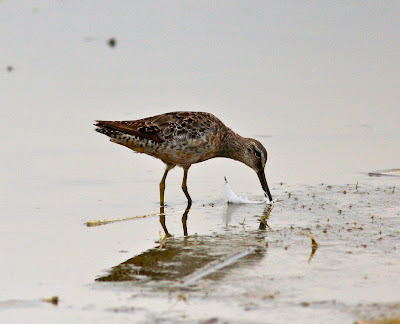Perhaps the best thing about this year is actually learning the local birds - as in really learning them. It has been many years since I looked at Shorebirds; in fact, before this year, the last time I spent a solid multi-day block of time on shorebirds, was probably in Thailand in 2003. So my immersion in the shorebirds of Long Island has been a lot of fun.
Today I learned some new things - partly about birds, but more importantly about how I approach bird identification. As I was heading down to the bay this morning, I got a call from Derek Rogers who had found a peep that seemed very odd/promising to him. He described a bird that was smaller than the Semipalmated Sandpipers, had black legs, lots of white-edged rufous on the back, short projection, and a short bill. A simple sentence, but right there he had eliminated 7 of the 9 peeps (black legs eliminate Least, Temmink's and Long-toed, the short bill eliminates Western, short projection eliminates Baird's and White-rumped, and the rufous eliminates Semipalmated). What's left are Red-necked and Little Stints; both very good birds in the Eastern US.
I had plans to get gas and breakfast on my way to the bay, but after the call, I went straight to the parking lot. Derek was still there but on his way out. He had some distant photos but it was clear that I needed to get some better ones and get a better look at the bird. I booted up and headed in to the East Pond.
I quickly found "the bird" and took a bunch of photos - I tend to shoot at a distance and then crop later so its really hard to see anything meaningful on the viewfinder of the camera after the fact. The bird was interesting though and I went through the process of eliminating options.
Black legs: not Temmink's Stint, Least Sandpiper, or Long-toed Stint.
Short projection: not White-rumped Sandpiper, or Baird's Sandpiper.
Rufous of the uppersides: not a Semipalmated Sandpiper.
Short Thick Bill (and no 'anchors' on scapulars): not Western Sandpiper, or Little Stint.
Black/rufous wing-coverts: not Red-necked Stint (they would be gray).
Which leaves .... well nothing really.
So having eliminated all 9 peeps I was at a bit of a loss and sat staring at the photos for a long time while Derek texted me for an opinion or an answer. I might have waited until I got to my bird book library on Friday but I had to consider "other birder" pressure - if this was something good/rare, and it was subsequently identified as such, folks would be mad that I hadn't got the word out promptly giving them a chance to see it. So I either had to posit an ID, or ask for help.
Logically, either this was a new species (a tad unlikely), or one of my rules for peep ID was wrong. So assuming my rules were wrong I started to go back through them, and ask some tangental questions. Clearly Little Stint was top of mind given the recent sighting in Connecticut. Is that bill short/straight enough? Not really. Is that a fork in the eye-strip? Yes, sort of, but not really as pronounced as it should be. Are those 'white braces'? Yes, sort of .... but overall, the bird just didn't feel right.
So was I missing something with the bird? Was that mud covering green legs and not black legs after all? Again, perhaps, but even if it was, the bill was just too thick for Least.
The one question I didn't ask, interestingly enough, was "do Semipalmated Sandpipers sometimes have rufous uppersides?" For some reason this was hard-coded as an absolute rule in my mind, and probably had been for many years.
So coming to a dead end, and feeling the pressure to get the word out quickly, I folded, and e-mailed Shai Mitral and Andrew Baksh. I also threw up some photos on the New York Birders page on Facebook. Derek in the meantime, had e-mailed his pal David Sibley.
The quick answer was that this was an unusually bright and colorful Semipalmated Sandpiper. Duh ....
So the lesson learned. Get out of the rule set and look at the bird. If a bird doesn't fit into the model, then take a step back and think about what it looks like. Learned a lot today ....






































